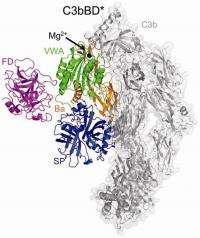Structure of key molecule in immune system provides clues for designing drugs

(PhysOrg.com) -- A team from the University of Pennsylvania School of Medicine and Utrecht University has deciphered a key step in an evolutionarily old branch of the immune response. This system, called complement, comprises a network of proteins that "complement" the work of antibodies in destroying foreign invaders. It serves as a rapid defense mechanism in most species from primitive sponges to humans.
In a study published in the December 24 issue of Science, the groups of John Lambris, PhD, the Dr. Ralph and Sally Weaver Professor of Research Medicine at Penn, and Piet Gros at Utrecht, detail the atomic structure of two key transient enzyme complexes in the human complement system.
Complement proteins mark both bacterial and dying host cells for elimination by the body's cellular cleanup services and have been implicated in at least 30 diseases, including stroke, myocardial infarction, and age-related macular degeneration. The findings, Lambris says, provide a molecular scaffold for designing novel drug therapeutics.
"Now we will be able to design specific complement inhibitors to target this complex and in that way inhibit activation of the complement cascade, because now we know which parts of the proteins are essential for activity," Lambris says.
Guided By Self-Control
The complement system is a form of "innate," or generic immunity, unlike "adaptive" immune responses, in which cellular mediators such as B and T cells learn to target specific antigens through recognition by either antibodies or cell receptors. The complement process unfolds as a complex biochemical network of molecular and cellular communication events, which result in the destruction and elimination of pathogens and damaged cells and eventual recruitment of immune cells.
The two enzyme complexes Lambris studied, called C3bB and C3bBD, drive a central step in amplifying the response by complement proteins. In that step, the complement protein C3 is enzymatically cleaved to form C3b, which binds to the surface of a target cell. C3b then binds factor B to produce C3bB. This complex, in turn, binds another enzyme, factor D (producing C3bBD), which cleaves the complex to form the active C3bBb. The major target of the active C3bBb is C3 itself, resulting in rapid amplification of the complement cascade.
To capture structural snapshots of C3bB and C3bBD, the researchers first generated mutant proteins that would stabilize the complexes in their active forms. Then, Lambris and Gros used x-ray crystallography to describe the two complexes in atomic detail. They found that, upon binding to C3b, factor B changes its shape to form an "open complex," which can then be bound by factor D. Factor D, in turn, shifts its shape in a more subtle yet no less important way: The free protein is inactive because a protein loop blocks the active site of the enzyme. Upon binding to C3bB, that loop alters its position, thereby activating factor D to cleave C3bB into the C3bBb complex.
These findings, Lambris said, provide molecular explanations for several safety features of the complement system. First, they explain why factor D is inactive on its own, but active when engaged by C3bB. They also illustrate a "double safety catch" mechanism the system uses to keep itself in check, preventing complement activation in the absence of a target.
Finally, and perhaps most importantly, they provide data that can aid the design of inhibitors against factor D, which may prove useful in the treatment of complement-associated diseases.
"Besides shedding light on a highly elegant mechanism of concerted activation and intrinsic regulation, this work also offers a detailed insight into one of the most important therapeutic targets within the complement network, which may facilitate rational drug development and could lead to novel drugs for treating complement-related diseases," Lambris says.


















